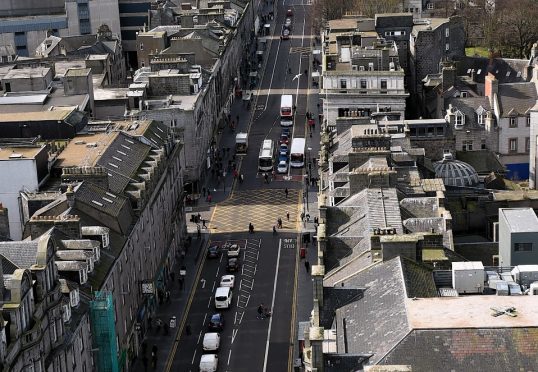Aberdeen’s transport future is to be put to the people, with council bosses aiming to bring about a culture change in the way residents travel across the city.
A huge number of roads are set for reclassification as the local authority looks to encourage people onto the recently completed Aberdeen bypass and away from the city centre.
Should that plan be approved by councillors, the city will then move on to a massive public consultation on the future of transport across the city.
Its Sustainable Urban Mobility Plan (SUMP) includes radical suggestions like slashing speed limits, investigating restricting Union Street to local drivers only and introducing new bus and bikes lanes.
One of the aims of the council’s 25-year city centre masterplan is to increase pedestrianisation and improveme of walking, bus and cycling infrastructure.
The Scottish Government has also encouraged the implementation of low emission zones (LEZ), which would mean high polluting vehicles being banned or charged for entering city centres.
Aberdeen, and the north-east generally, has a high level of car ownership and use among the population.
Areas of the city are ranked among the worst in Scotland for air pollution – with many heavy lorries using the likes of Union Street to move goods north.
Councillors on next week’s city growth committee are asked to approve the reclassification and review junctions following the competition of the AWPR, which will also require new signage.
Following the opening of the £1 billion bypass, large parts of trunk roads like Anderson Drive on the A90 – that government agency Transport Scotland used to be responsible for – will now be maintained by the local authority.
The report reads: “The opening of the Aberdeen Western Peripheral Route (AWPR) offers a unique opportunity to re-think and redesign Aberdeen’s transport network.
“With the need to react to the potentially catastrophic impacts of climate change and the significant public health implications of worsening air quality becoming more urgent every day and growing in the public consciousness, the council has a duty to respond to this and develop a long-term strategy for reducing the impacts of unrestricted vehicle use throughout our city.”
Council co-leader Douglas Lumsden said: “The main change we need to have is that we need to make the city centre somewhere you drive to and not through.
“Aberdeen is changing and we need to do everything in our power to make the city centre a vibrant attractive place for our citizens and tourists alike.”
Liberal Democrat infrastructure spokesman Steve Delaney said: “I would welcome this report as a first step towards locking-in the benefits of the AWPR and making the most of reduced traffic flows within the city, and the city centre in particular.
“Moving towards a car-free city centre must be our goal, but we need to get this right for all citizens in order for it to work efficiently and effectively”.
SNP city growth spokesman Alex Nicoll said: “It’s disappointing that we’ve had to wait this long for the administration to bring forward a report but it’s clear that there is still a significant amount of work to be done in relation to some aspects, most notably car parking.
“Ultimately, this is going to be a long term process requiring significant investment and the administration’s miserable record on delivering the likes of the Berryden Corridor and South College Street upgrading does raise cause for concern.”
